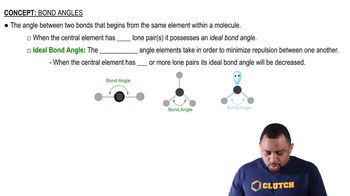Here are the essential concepts you must grasp in order to answer the question correctly.
Molecular Geometry
Molecular geometry refers to the three-dimensional arrangement of atoms within a molecule. The shape of a molecule is determined by the number of bonding pairs and lone pairs of electrons around the central atom, which influences the bond angles. In the case of lactic acid, understanding its geometry helps predict the bond angles around each carbon atom.
Recommended video:
Molecular Geometry with Two Electron Groups
Hybridization
Hybridization is the concept of mixing atomic orbitals to form new hybrid orbitals that can accommodate bonding. In lactic acid, the carbon atoms undergo sp3 hybridization, which results in tetrahedral geometry. This hybridization explains the bond angles, typically around 109.5 degrees for sp3 hybridized carbons.
Recommended video:
Bond Angles
Bond angles are the angles formed between two bonds that share a common atom, crucial for understanding molecular shape. In lactic acid, the bond angles around the carbon atoms vary due to the presence of different substituents and hybridization. For sp3 hybridized carbons, the ideal bond angle is approximately 109.5 degrees, but steric effects from adjacent groups can slightly alter this angle.
Recommended video:




